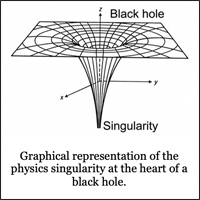Einstein’s Explanation of the Unexplainable
In an earlier post An alternative to a singularity? Aug 15 2008 we defined what happens to matter and energy as it falls into a black hole in terms of inertial reference frames. However, we did not attempt to define what happens after that. The reason was because we must use Einstein’s mathematical definitions of the curvature in the geodesics that define how mass and energy move in a space-time environment to do so. They tells us that it would take an infinite amount of time mass and energy to form singularity after passing through the event horizon of a black hole for the same reason we that observe it to take an infinite amount of time to reach it from the outside.
This is because as mass is added to it the curvature defining the gravitational geodesic that defines its event horizon expands adding another layer to it. However, that does not mean the matter that is under that layer is free to move towards its center because the gravitational curvature in the geodesic that defines its movement is still there but at a lower gravitational potential. This means any matter that exists at a lower level could NOT move towards its center to form a singularity because according to Einstein’s math it can only move around the geodesic generated by the gravitational potential at that level. This tells us it would take an infinite amount of time to cross to a lower gravitational level for the same reason as it would take an infinite amount of time for it to pass through the event horizon which defines the existence of a black hole.
This also tells us that we have either misinterpreted the math that tells us a singularity can exist at the center of a black hole or we must rewrite them based on the observations of how mass and energy interact with the event horizon of a black hole. We DO NOT believe we have any other options base on those observations.
So if a singularly is not at the center of a black hole what is.
We know the densest form of observable matter is found in a neutron star where the gravitational forces are strong enough to overcome the forces keeping electrons protons and neutron apart. We also know that a neutron star is capable of becoming a black hole if it absorbs enough mass and energy to become one. However, that does not mean that it collapses to a singularity. This is because according Einstein math a black hole could be the result of enough matter accumulating on its surface to cause its gravitational geodesic to circle back on itself. Putting it another way a black hole may just be made up of SOLID BALL of the extremely dense mass of neutrons.
Copyright Jeffrey O’Callaghan Mar. 2021
The Road to Unifying | The Road to Unifying | The Road to Unifying |


